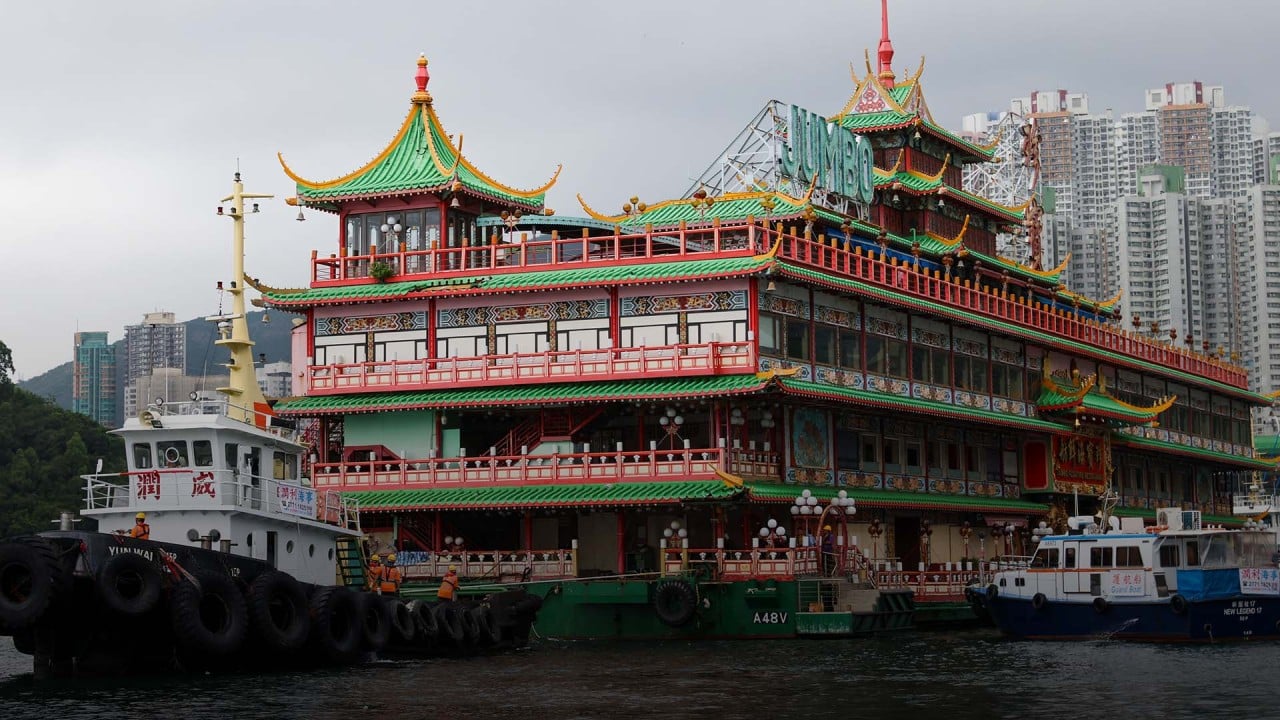
Explainer | What happened to Hong Kong’s Jumbo Floating Restaurant? Everything you need to know about the ill-fated tourist attraction
- Imperial palace-like vessel sank in South China Sea after encountering adverse weather when it approached Paracel Islands
- Restaurant has been a landmark since its opening in 1976, with famous guests from around the world visiting
The Post unpacks the saga of the ill-fated floating restaurant.
What happened to the Jumbo Floating Restaurant?
Its parent company, Aberdeen Restaurant Enterprises, revealed on Monday that the 46-year-old tourist attraction had encountered adverse weather when it approached the Xisha Islands, or Paracel Islands, in the South China Sea on Saturday afternoon, after its departure from Hong Kong on June 14.
“Water entered the vessel, which began to tip. Despite the efforts of the towing company responsible for the trip to rescue the vessel, unfortunately it capsized on Sunday,” it said.
While no crew members were injured, the company added: “The water depth at the scene is over 1,000 metres [3,300 feet], making it extremely difficult to carry out salvage works.”
It said it was “very saddened” by the incident and it was requesting more information from the towing firm.
The company spokesman told the Post he had no information on the financial loss or whether the salvage operation would continue. He also declined to reveal the restaurant’s exact destination.
Hong Kong’s Marine Department, however, revealed on Tuesday night that it had permitted the vessel to leave the city for Cambodia on June 14, after the owner appointed surveyors to conduct inspections to ensure it was suitable for the journey.

What is the restaurant’s history?
The imperial palace-like restaurant has been an iconic landmark in the city since its opening in 1976.
Sin Pui-on, a 71 year-old Aberdeen native who studies the history of floating restaurants, said there were at most seven floating restaurants sitting in the Aberdeen Typhoon Shelter during the 1950s. The major ones were Tai Pak and Yue Lei Tai, while others were of a smaller scale.
“[Fishermen in Aberdeen] modified some of their larger boats into those floating restaurants, where others would host weddings and birthday parties,” said Sin, whose uncle founded Yue Lei Tai.
“The restaurants gradually grew into larger-scale floating restaurants, which began to attract many tourists.”

Yue Lei Tai was eventually acquired by another company and renamed Sea Palace Floating Restaurant in the 1960s.
Construction for the Jumbo Floating Restaurant began in 1970, but a fire burned it down in 1971, killing 34 people and injuring more than 40.

Sin said tycoons Stanley Ho Hung-sun and Cheng Yu-tung then invested HK$32 million (US$4 million) to rebuild the structure, which eventually opened in 1976 and became the biggest floating restaurant in the city.
The three floating restaurants – Jumbo, Tai Pak and Sea Palace – were relocated to Sham Wan in 1978 due to reclamation in the typhoon shelter.

After Jumbo acquired the other two in the 1980s, Tai Pak’s facility was placed next to Jumbo, but it was not relocated along with the latter this month.
Sea Palace was successfully relocated twice. It was sold and moved to Manila Bay in the Philippines in 1999 and rebranded as the Jumbo Kingdom Manila, which closed down in 2008. Three years later, it was given to Qingdao in mainland China and spent eight days at sea on the deck of a semi-submersible vessel. But it was reportedly never used and remained docked in the city.

Which celebrities visited the restaurant in its heyday?
Situated among small fishing boats and luxury yachts, the 76-metre-long restaurant had three storeys with 45,000 sq ft of space in total, and could accommodate up to 2,300 diners.
In its heyday, along with the other two floating restaurants, the tourist attraction drew in many visitors from around the world, including Britain’s Queen Elizabeth and film stars such as Tom Cruise and Chow Yun Fat.
It also appeared in films such as The Man With the Golden Gun (1974) from the James Bond series, Contagion (2011), The Protector (1985), The God of Cookery (1996) and Infernal Affairs II (2003).
Other than its banquet meals, one of the restaurant’s main attractions was its sumptuous design resembling an imperial palace from the Ming dynasty.
Its red, green and gold exterior was embellished with dragons and pagodas, while its interior was adorned with lavish paintings, ceramics and motifs.
A company manager told the Post in 1976 that the decoration and the equipment were worth HK$10 million and HK$16 million respectively.

Why was it being relocated?
The restaurant had suspended operations in 2020 as it suffered an accumulated loss of HK$100 million due to the Covid-19 pandemic and the social unrest in 2019 sparked by the now-withdrawn extradition bill.

The company announced in late May that the restaurant would move away from Hong Kong for repairs and storage due to a lack of funds for maintenance, adding that it would wait for a new operator to take over.
It said millions had been spent annually on inspections, repairs and maintenance, calling it a “heavy financial burden” under the current economic environment.
Ocean Park originally had plans to take over the restaurant as proposed in the 2020 policy address, but the theme park failed to find a suitable third party to operate it.
Chief Executive Carrie Lam Cheng Yuet-ngor said the government would not subsidise the attraction, adding that it could do nothing if both parties had failed to reach an agreement.
After the company’s shocking announcement, many Hongkongers expressed regret, calling on the government to save the restaurant, while lawmakers urged authorities to provide support to keep Jumbo afloat.
Nevertheless, the restaurant eventually bid a permanent farewell to Hong Kong and began its fateful journey on June 14.


